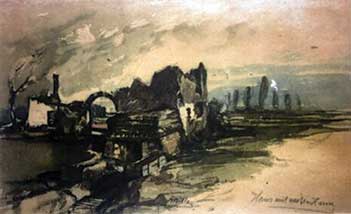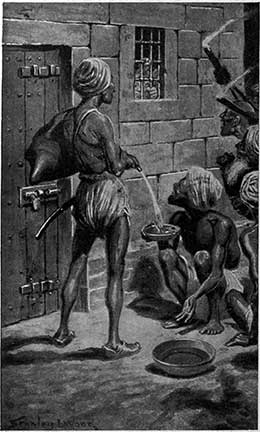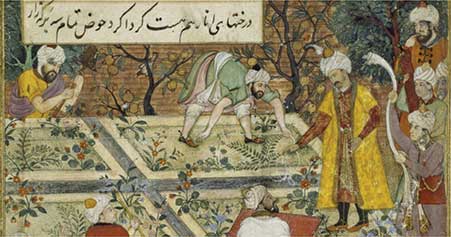Deborina Roy
Two girls, Payel and Sumitra were returning from school. On their way home, Payel pointed to the new leaves of the potato plants in the kitchen garden of her house. Sumitra immediately wanted to dig up the potatoes and take them home. Payel stopped her and said that her teacher had told her that this is a vegetable that came to India years ago. Sumitra had always thought this vegetable to be ordinary. The next day both the girls discussed this with their school teacher who narrated how this vegetable came from Peru and Bolivia, where it was cultivated 1800 years ago by the Incas who were the earliest civilizations of South America. The teacher even told the girls that it was the Portuguese who brought this vegetable to India in the 17th century.
I have narrated this story to illustrate the fact that out of all school subjects, history has the reputation of being the most “boring”. Yet it is a subject that is such an integral part of our society, identity, the everyday happenings around us affecting our heritage and culture. Therefore, it is all the more important that students are taught history in such a way that they fall in love with the subject and learn to value their own culture, community, and country.
The most important role is played by the teacher teaching the subject in the class. The teacher must be passionate about the subject, must not be biased while presenting facts, must be willing to think out-of-the box while planning projects, must be able to relate it to students’ everyday experiences, and last but not the least, must always be updated with the latest research in the subject.
There are many strategies and methodologies that can be adopted in a classroom. NEP 2020 lays emphasis on ‘Art integrated Learning’, interdisciplinary approach, and development of the skill of critical analysis. Other than these, I feel it is essential to adopt experiential learning, thematic teaching and allowing the students to learn by exploration. I will elaborate on all of these and many more teaching strategies and project ideas in this article.

The story way
One strategy that works very well with students is the story method where the history teacher needs to bring alive the character of any important historical figure that is part of the syllabus with stories that are not found in school textbooks. I am going to quote the life of Akbar, or of Hitler, or Michelangelo as an example to illustrate my point to teachers or fellow colleagues. While teaching students mostly in grades 6 to 9, about the reign of Akbar, his battles or about the administration, it is important to talk about his childhood days, and what his life changing experiences were when his father Humayun won back the throne and how it left a deep scar in the mind of an 11-year-old. The ‘petticoat government’ is another story that can be told to make students understand how Akbar came out of all influences and formulated his own administrative policies. It also never hurts to tell the story of Anarkali in order to give a complete picture of Akbar’s persona. In this regard I would state an absolute ‘no’ to give a tag to any ruler. There is no need to say, “Today we will learn about Akbar the Great.” It is always advisable that historical characters and events are left open for discussion, where students can critically analyze and come up with their own conclusions. Similarly, stories of Hitler’s early life, his years in Vienna, and his paintings can throw so much light on his persona and how his life experiences shaped him as a person and influenced his decisions.
Another story that I have often used in classrooms while teaching colonial history in India is that of the ‘Black Hole tragedy of Kolkata.’ This story in fact had the John Holwell’s version was an established fact for many years till 1959 when both Brijen Gupta and Maren Goldberg revised the facts. This also gives me enough opportunity to delve into the darker side of Siraj ud Dullah, and whether Mir Jafar can actually be categorized as a traitor. This story also gives me a chance to bring forth facts about the British-patronised growth of the Babu culture in Bengal, the Indian economy at that time, the colonial crippling of our industries and connecting it into the concept of right interpretation of history. Thus, I would like to state that through the narration of one such story, many aspects of colonial history can be taught depending upon how a particular set of facts are relevant to a topic being taught in class by the teacher. The history teacher must always choose a story which can be debated and explored in order to induce students to think beyond set conclusions.
Usage of film clippings, documentaries and audio-visuals
This has now become a very common tool of teaching, especially after the pandemic. The liberal use of PPTs and all other kinds of digital media is very common. I would like to state that film clippings, if used in classrooms, can be very effective while trying to make a point clear as a concept. Popular films like ‘Jodha Akbar’ effectively demonstrate the battle strategies especially in the scene that is based on the second battle of Panipat. The BBC interview of Mrs. Indira Gandhi is really helpful in understanding the Emergency period in Indian politics, a topic that must be left completely for the students to analyze. Also clippings from movies like ‘Forest Gump’, ‘The Pianist’, ‘The Boy in Striped Pyjamas’ are absolutely great ways to make the students understand how the World War affected lives. Even the famous ball kicking scene from Charlie Chaplin’s movie “The Great Dictator” or his speech in that movie are excellent resources to make students understand Nazism and the effects of dictatorship. They should be used by the teacher in the class while teaching the topic and by generating questions which are from the understanding of the movie and help them to critically analyze that period in history. Students should also be exposed to documentaries, verified news clippings and social media posts that can be questioned and debated in the classroom.

Inter-disciplinary teaching
History should not be taught in isolation. It is a subject that is connected to almost every other school subject and therefore an inter-disciplinary approach is an excellent way to teach it. Here is an example to illustrate my point. When we want to teach the period of the Great Depression of the 1930s, a teacher can start from 1920s period of boom in the American economy. The Ford company that started with the supply line production method of mechanising the production process led to the creation of the concept of “credit” in the market and the banking system went for an overhaul. This can be connected to the banking system which is taught in economics and how the credit system runs a parallel currency along with paper money. Also, the gender inequality in terms of wages and labour in factories that started right from the period after the First World War in Germany, with more women joining the workforce, can again be connected with economics while teaching factors of production and labour in particular.
In Indian history the slump of Indian manufacturing units during the British period of colonisation and the complete takeover of the Indian market can be connected to the laws of supply and demand, a vital part of the basics of economics. Another example would be to connect chemistry with history while teaching about the different weapons that were invented during the First World War. Similarly, while explaining about the Maratha attack on the Mughals after Shivaji’s return from imprisonment by Aurangzeb, the teacher can connect the war strategies with the geographical aspects of that region. Even while teaching the different river valley civilizations the teacher must link it to geography and create that skill of critical analysis among students in order to understand the lifestyle or town planning of these civilizations. While teaching mughal architecture or Leonardo da Vinci’s art, mathematics can be linked with history to explain the use of mathematics in architecture, painting, and sketches.
Art – integrated Learning
Most CBSE school teachers have to now implement this method while trying to impart their lesson. This is one of the most enjoyable methods of teaching history. To explain this point I am going to state a few examples. One of the common topics of civics is the Preamble of the Indian Constitution. Generally the approach to teaching this is to only focus on the different goals and objectives enumerated in the Preamble and explain them. However, little attention is given to the other important aspects of the Indian Constitution. One of that is to tell the students about the artwork in the Preamble by Nandalal Bose, and the border design by Beohar Rammanohar Sinha. Then the next step is to ask the students to design their own class constitution having a preamble page with artwork by the students that is relevant to the goals, objectives, and laws that they have set for themselves. This is therefore not only an example of simply integrating art but also making sure that the students learn about the importance of a constitution and preamble.
Experiential Learning
This is perhaps the most challenging and interesting method of teaching and learning with respect to history. This method focuses on the experience of the students to help them understand a concept. The teacher has to think innovatively and plan in detail. In this method, the teacher only plays the role of a facilitator. One example of this is when the teacher wants to teach about Muhammad-bin-Tughlaq. The teacher can divide the class into four groups, give them four problems that are related to their lives and ask the students to solve it. Then they must be given the four problems that Muhammad-bin-Tughlaq solved and asked to think like a ruler, without revealing what he had actually done. Once all the groups have found a solution, they must present it to the class and justify their solutions. Thereafter, the teacher can proceed to explain what Muhammad-bin-Tughlaq did and ask the students to compare his actions with their solutions and thus critically analyze the ‘mistakes’ by Muhammad-bin-Tughlaq. Thus, the students learn from their own experience of trying to solve problems and develop critical thinking. Similarly, the teacher can recreate similar experiential learning situations while teaching any topic in civics and the laws that are enumerated in the Constitution. It can be taught while studying any war or conflict in history.

Teaching by exploration
History teachers have a wide scope of taking students to museums, galleries, exhibitions, and without teaching the topic in class, they can ask students to look at exhibits and find out facts and collate them, working either singly or in groups. After the fact finding activity is done, students will research the facts gathered and present their learning to their peers. All facts that students share in the classroom can be displayed by the teacher and the class learns from each other through this method of exploration of a topic. This sort of exploration can also be done by asking the students to search the internet on a given topic. Another date must be set up and similar peer teaching can be conducted.
In this way the students learn about a topic without the teacher giving a single input. Some topics that can be taught in this way are the different stone ages, the periods following that, the ancient methods of mummification, pyramid building, Mughal architecture, rock carved temple architecture of ancient times, art and sculpture during the period of Renaissance in Europe, civil rights movement in America, and many more.
In this article I have mostly dealt with teaching methodologies that are possible for any history teacher to adapt in any part of the country in any school and in any type of classroom without any logistical problem. I would like to reiterate once more that the teacher must first love the subject in order to inculcate that love among the students. Only then can history shed the tag of being a boring subject and come alive in classrooms.
The author is the Headmistress at Indus Valley World school, and former Head of the Department of History at Loreto Day School, Bowbazar, Kolkata, and has more than 20 years of history teaching experience of the CBSE, ICSE & ISC, and IGCSE curriculum. She is also a member of two organizations called Bichitra Pathshala and Own The Past, that deal with creating awareness regarding our country’s history and heritage. She can be reached at maildeborina@gmail.com.
